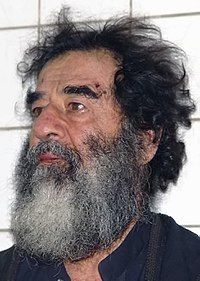
A | B | C | D | E | F | G | H | CH | I | J | K | L | M | N | O | P | Q | R | S | T | U | V | W | X | Y | Z | 0 | 1 | 2 | 3 | 4 | 5 | 6 | 7 | 8 | 9

The Occupation of Iraq (2003–2011) was characterized by a large United States military deployment on Iraqi territory, beginning with the US-led invasion of the country in March 2003 which overthrew the Ba'ath Party government of Saddam Hussein and ending with the departure of US troops from the country in 2011. Troops for the occupation came primarily from the United States, the United Kingdom, and Australia, but 29 other nations also provided troops, and there were varying levels of assistance from Japan and other countries, as well as tens of thousands of private military company personnel.
It was a period of violence and political turmoil, and saw strong foreign influence exerted on Iraqi politics. In April 2003, a military occupation was established and run by the Coalition Provisional Authority (CPA), which later appointed and granted limited powers to the Iraq Interim Governing Council. In June 2004, the Iraqi Interim Government, a caretaker government, was established, ending the international armed conflict between the U.S.-led Coalition and Iraq. Following parliamentary elections in January 2005, this administration was replaced in May by the Iraqi Transitional Government. A year later, the Al Maliki I Government took office.
Efforts toward the reconstruction of Iraq after the damage of the invasion were slowed when coalition and allied Iraqi forces fought a stronger-than-expected militant Iraqi insurgency, leading to difficult living conditions for the population of Iraq throughout the period.
Military occupation
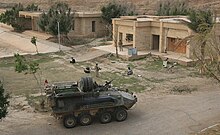
A military occupation was established and run by the Coalition Provisional Authority (CPA), which later appointed and granted limited powers to an Iraq Interim Governing Council. Troops for the invasion came primarily from the United States, the United Kingdom, and Australia, but 29 other nations also provided some troops, and there were varying levels of assistance from Japan and other allied countries. Tens of thousands of private security personnel provided protection of infrastructure, facilities and personnel.
Coalition and allied Iraqi forces fought a stronger-than-expected militant Iraqi insurgency, and so the reconstruction of Iraq was slow. In mid-2004, the direct rule of the CPA was ended and a new "sovereign and independent" Interim Government of Iraq assumed the full responsibility and authority of the state. The CPA and the Governing Council were disbanded on 28 June 2004, and a new transitional constitution came into effect.[1]
Sovereignty was transferred to a Governing Council Iraqi interim government led by Iyad Allawi as Iraq's first post-Saddam prime minister; this government was not allowed to make new laws without the approval of the CPA. The Iraqi Interim Government was replaced as a result of the elections which took place in January 2005. A period of negotiations by the elected Iraqi National Assembly followed, which culminated on 6 April 2005 with the selection of, among others, Prime Minister Ibrahim al-Jaafari and President Jalal Talabani. Prime Minister al-Jaafari led the majority party of the United Iraqi Alliance (UIA), a coalition of the al-Dawa and SCIRI (Supreme Council for the Islamic Revolution in Iraq) parties. Both parties are backed by Tehran, and were banned by Saddam Hussein.
Legal status of the coalition presence
An international armed conflict (IAC) between the United States and Iraq in the Iraq War began when the US-led Coalition invaded Iraq on March 19, 2003. IAC continued after the invasion when the Coalition Provisional Authority (CPA) was established on April 21 to temporarily administer the domestic affairs of Iraq. Therefore, hostilities during the invasion and occupation of Iraq fell under the laws of war applicable to IAC, including the 1949 Geneva Conventions, to which the US and Iraq are parties to, and the 1907 Hague Convention IV - The Laws and Customs of War on Land, which is commonly accepted as customary international humanitarian law binding on non-signatories engaged in an IAC.[2] According to Article 42 under Section III of the Hague Convention IV - The Laws and Customs of War on Land, "erritory is considered occupied when it is actually placed under the authority of the hostile army."[3]
There may be situations where the former occupier will maintain a military presence in the country, with the agreement of the legitimate government under a security arrangement (e.g., US military presence in Japan and Germany). The legality of such agreement and the legitimacy of the national authorities signing it are subject to international recognition, whereby members of the international community re-establish diplomatic and political relations with the national government.
United Nations Security Council Resolution 1546 in 2004 looked forward to the end of the occupation and the assumption of full responsibility and authority by a fully sovereign and independent Interim Government of Iraq.[4] Afterwards, the UN and individual nations established diplomatic relations with the Interim Government, which began planning for elections and the writing of a new constitution. As a result, the Iraq War after June 28, 2004 became a non-international armed conflict (NIAC), since US-led Coalition troops were operating in the country with the consent of the new legitimate government of Iraq. Therefore, hostilities in post-occupation Iraq fell under the laws of war applicable to NIAC, including Common Article 3 of the 1949 Geneva Conventions.
In January 2005, John Negroponte, US ambassador to Iraq, indicated the US government would comply with a United Nations resolution declaring that coalition forces would have to leave if requested by the Iraqi government. "If that's the wish of the government of Iraq, we will comply with those wishes. But no, we haven't been approached on this issue – although obviously we stand prepared to engage the future government on any issue concerning our presence here."[5]
On 10 May 2007, 144 Iraqi Parliamentary lawmakers signed onto a legislative petition calling on the United States to set a timetable for withdrawal.[6] On 3 June 2007, the Iraqi Parliament voted 85 to 59 to require the Iraqi government to consult with Parliament before requesting additional extensions of the UN Security Council Mandate for Coalition operations in Iraq.[7] The UN mandate under United Nations Security Council Resolution 1790 expired on 31 December 2008.
Occupation (April 21, 2003–June 28, 2004)
An international armed conflict (IAC) between the US and Iraq in the Iraq War began when the US-led Coalition invaded Iraq on March 19, 2003. IAC continued after the invasion when the CPA was established on April 21 to temporarily administer the domestic affairs of Iraq. Therefore, hostilities during the invasion and occupation of Iraq fell under the laws of war applicable to IAC, including the 1949 Geneva Conventions, to which the US and Iraq are parties to, and the 1907 Hague Convention IV - The Laws and Customs of War on Land, which is commonly accepted as customary international humanitarian law binding on non-signatories engaged in an IAC.[2]
2003
Fall of Saddam Hussein's government
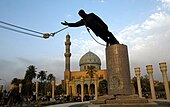
Schools, police, courts, government, and military were shut down, which meant that most Iraqis were unemployed.[8] Cities, especially Baghdad, suffered through reductions in electricity, clean water, and telephone service from pre-war levels, with shortages that continued through at least the next year.[9]
On 1 May 2003, President of the United States George W Bush declared the "end of major combat operations" in Iraq, while aboard the USS Abraham Lincoln with a large "Mission Accomplished" banner displayed behind him. The weeks following the removal of Ba'ath Party rule were portrayed by American media as generally a euphoric time among the Iraqi populace. New York Post correspondent Jonathan Foreman wrote from Baghdad in May 2003 that "the intensity of the population's pro-American enthusiasm is astonishing".[10]
There were widespread reports of looting, though much of the looting was directed at former government buildings and other remnants of the former government, and reports of losses of up to 170,000 items of Iraq's archaeological treasures worth billions of US dollars, mostly from the National Museum of Iraq,[11] were later revealed to be vastly exaggerated.[12][13]
Insurgency begins
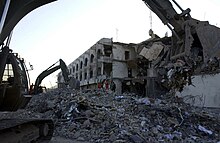
In the summer of 2003, the US military focused on hunting down the remaining leaders of the ousted government, culminating in the killing of Saddam's sons Uday Hussein and Qusay Hussein on 22 July.[14] In all, over 200 top leaders of the former regime were killed or captured, as well as numerous lesser functionaries and military personnel.
After the initial invasion, most of the Iraqi military's former soldiers and officers offered little resistance to Coalition forces in the early days of the occupation. Many soldiers had simply gone home rather than openly fight the invading forces. This seeming acceptance of Coalition authority stemmed from the US military continuing to pay the salaries of Saddam's former soldiers, while promising senior Iraqi officers that they would have a major role to play "in building a new Iraq."
However, on 11 May 2003, the Bush Administration established the "Coalition Provisional Authority" (CPA) to take control of Iraq's domestic affairs away from the US military. Twelve days later, Paul Bremer, head of the CPA, issued an order dissolving the entire Iraqi military, as well as most civilian employees of the old government, and pledged to build a new military and government from scratch. One "untainted by any ties to Saddam's regime," according to the CPA. The Iraqi army's abrupt end, against the protests of many US field commanders, sparked immediate rioting among former Iraqi soldiers. In addition to broader civil unrest as unemployment skyrocketed to 70% and practically every government service, from the police to trash collectors, ended without warning.[15] Soon, large numbers of former Iraqi military personnel allied with the surviving Ba'ath loyalists and formed guerrilla units, igniting an eight-year insurgency against Coalition forces. Besides scattered attacks in Baghdad, these insurgents began to focus on taking and holding ground in and around Mosul, Tikrit, and Fallujah. In the fall of 2003, these largely secular units were joined by religiously motivated "Jihadists" insurgents, both foreign and domestic. With the growing influence of religious fanatics, the insurgency's mostly traditional tactics of sniping, small unit ambushes and planting roadside improvised explosive devices against foreign military personnel began transforming into frequent suicide bombings and death squads targeting civilians that were perceived as "loyal" to coalition forces.[15]
They favored attacking the unarmored Humvee vehicles, and in November they successfully attacked US rotary aircraft with SA-7 missiles bought on the global black market. On 19 August, the UN Headquarters in Baghdad was destroyed in the Canal Hotel Bombing, killing at least 22 people, among them Sérgio Vieira de Mello, Special Representative of the UN Secretary General.
Saddam captured and elections urged
In December 2003, Saddam himself was captured. The provisional government began training a security force intended to defend critical infrastructure, and the US promised over $20 billion in reconstruction aid in the form of credits against Iraq's future oil revenues. At the same time, elements left out of the Iraqi Patriotic Alliance (IPA) began to agitate for elections. Most prominent among these was Ali al-Sistani, Grand Ayatollah in the Shia sect of Islam.
The United States and the Coalition Provisional Authority, run by Jay Garner and three deputies, including Tim Cross, opposed allowing democratic elections at this time, preferring instead to eventually hand over power to an unelected group of Iraqis.[16] More insurgents stepped up their activities. The two most turbulent centers were the area around Fallujah and the poor Shia sections of cities from Baghdad to Basra in the south.
January 1, 2004–June 28, 2004


Spring fighting
In the spring, the United States and the Coalition Provisional Authority decided to confront the rebels with a pair of assaults: one on Fallujah, the center of the "Mohammed's Army of Al-Ansar", and another on Najaf, home of an important mosque, which had become the focal point for the Mahdi Army and its activities. In Fallujah four private security contractors, working for Blackwater USA, were ambushed and killed, and their corpses desecrated. In retaliation a US offensive was begun, but it was soon halted because of the protests by the Iraqi Governing Council and negative media coverage.
A truce was negotiated that put a former Ba'athist general in complete charge of Fallujah. The 1st Armored Division along with the 2nd ACR were then shifted south, because Spanish, Salvadoran, Ukrainian, and Polish forces were having increasing difficulties retaining control over Al Kut, and Najaf. The 1st Armored Division and 2nd ACR relieved the Spaniards, Salvadoran, Poles, and put down the overt rebellion.
At the same time, British forces in Basra were faced with increasing restiveness, and became more selective in the areas they patrolled. In all, April, May and early June represented the bloodiest months of fighting since the end of hostilities. The Iraqi troops who were left in charge of Fallujah after the truce began to disperse and the city fell back under insurgent control.
In the April battle for Fallujah, US troops killed about 200 resistance fighters, while 40 Americans died and hundreds were wounded in a fierce battle. US forces then turned their attention to the al Mahdi Army in Najaf. A large convoy of US Army supply trucks manned by civilian contractors was ambushed and suffered significant damage and casualties.
Transfer of sovereignty
On June 28, 2004, under the auspices of United Nations Security Council Resolution 1546, the CPA transferred limited sovereignty to a caretaker government, whose first act was to begin the trial of Saddam Hussein. The transfer marked the end of an IAC between the U.S. and Iraq. The new Iraqi government began the process of moving towards elections, though the insurgency, and the lack of cohesion within the government itself, led to repeated delays.
Militia leader Muqtada al-Sadr used his grass-roots organization and Mahdi Militia of over a thousand armed men to take control of the streets of Baghdad. The CPA soon realized it had lost control and closed down his popular newspaper. This resulted in mass anti-American demonstrations. The CPA then attempted to arrest al-Sadr on murder charges. He defied the American military by taking refuge in the Holy City of Najaf.
Post-occupation (June 28, 2004–December 15, 2011)
Hostilities between the US and Iraq ended on June 28, 2004 when the CPA handed over Iraqi sovereignty to the Iraqi Interim government as mandated by UN Resolution 1546. Throughout the Iraq War, US-led Coalition troops were operating in the country with the consent of the new legitimate government of Iraq. Therefore, the war in Iraq after June 28, 2004 became a non-international armed conflict (NIAC), which fell under the laws of war applicable to NIAC, including Common Article 3 of the Geneva Conventions.
June 28, 2004–December 31, 2004
Through July and August, a series of skirmishes in and around Najaf culminated with the Imman Ali Mosque itself under siege, only to have a peace deal brokered by al-Sistani in late August.[17] Al-Sadr then declared a national cease fire, and opened negotiations with the American and government forces. His militia was incorporated into the Iraqi security forces and al-Sadr is now a special envoy. This incident was the turning point in the failed American efforts to install Ahmed Chalabi as leader of the interim government. The CPA then put Iyad Allawi in power; ultimately he was only marginally more popular than Chalabi.
The Allawi government, with significant numbers of holdovers from the Coalition Provisional Authority, began to engage in attempts to secure control of the oil infrastructure, the source of Iraq's foreign currency, and control of the major cities of Iraq. The continuing insurgencies, poor state of the Iraqi Army, disorganized condition of police and security forces, as well as the lack of revenue hampered their efforts to assert control. In addition, both former Ba'athist elements and militant Shia groups engaged in sabotage, terrorism, open rebellion, and establishing their own security zones in all or part of a dozen cities. The Allawi government vowed to crush resistance, using US troops, but at the same time negotiated with Muqtada al-Sadr.
Offensives and counteroffensives
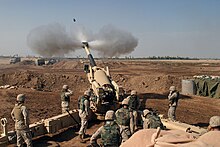
Beginning 8 November, American and Iraqi forces invaded the militant stronghold of Fallujah in Operation Phantom Fury, killing and capturing many insurgents. Many rebels were thought to have fled the city before the invasion. US-backed figures put insurgency losses at over 2,000. It was the bloodiest single battle for the US in the war, with 92 Americans dead and several hundred wounded. A video showing the killing of at least one unarmed and wounded man by an American serviceman surfaced, throwing renewed doubt and outrage at the efficiency of the US occupation.[18] The Marine was later cleared of any wrongdoing because the Marines had been warned that the enemy would sometimes feign death and booby-trap bodies as a tactic to lure Marines to their deaths. November was the deadliest month of the occupation for coalition troops, surpassing April.
Another offensive was launched by insurgents during the month of November in Mosul. US forces backed by peshmerga fighters launched a counteroffensive which resulted in the Battle of Mosul (2004). The fighting in Mosul occurred concurrently with the fighting in Fallujah and attributed to the high number of American casualties taken that month.
In December, 14 American soldiers were killed and over a hundred injured when an explosion struck an open-tent mess hall in Mosul, where President Bush had spent Thanksgiving with troops the year before. The explosion is believed to have come from a suicide bomber.
After a review of the military strategy in the end of 2004, then commanding general of the MNF-I, General George Casey directed the Coalition forces to shift their focus from fighting insurgents to training Iraqis.[19] At the time, the Iraqi insurgency was mainly directed against the occupation and it was believed that if the Coalition would reduce its presence then the insurgency would diminish. Military planners hoped that national elections would change the perception of being under occupation, stabilize the situation and allow the Coalition to reduce its presence.
2005
Iraqi elections and aftermath

On 30 January, an election for a government to draft a permanent constitution took place. Although some violence and lack of widespread Sunni Arab participation marred the event, most of the eligible Kurd and Shia populace participated. On 4 February, Paul Wolfowitz announced that 15,000 US troops whose tours of duty had been extended in order to provide election security would be pulled out of Iraq by the next month.[20] February, March and April proved to be relatively peaceful months compared to the carnage of November and January, with insurgent attacks averaging 30 a day from the average 70.
Hopes for a quick end to an insurgency and a withdrawal of US troops were dashed at the advent of May, Iraq's bloodiest month since the invasion of US forces in March and April 2003. Suicide bombers, believed to be mainly disheartened Iraqi Sunni Arabs, Syrians and Saudis, tore through Iraq. Their targets were often Shia gatherings or civilian concentrations mainly of Shias. As a result, over 700 Iraqi civilians died in that month, as well as 79 US soldiers.

During early and mid-May, the US also launched Operation Matador, an assault by around 1,000 Marines in the ungoverned region of western Iraq. Its goal was the closing of suspected insurgent supply routes of volunteers and material from Syria, and with the fight they received their assumption proved correct. Fighters armed with flak jackets (unseen in the insurgency by this time) and sporting sophisticated tactics met the Marines, eventually inflicting 30 US casualties by the operation's end, and suffering 125 casualties themselves.
The Marines succeeded, recapturing the whole region and even fighting insurgents all the way to the Syrian border, where they were forced to stop (Syrian residents living near the border heard the American bombs very clearly during the operation). The vast majority of these armed and trained insurgents quickly dispersed before the US could bring the full force of its firepower on them, as it did in Fallujah.
Announcements and renewed fighting
On 14 August 2005 the Washington Post quoted one anonymous US senior official expressing that "the United States no longer expects to see a model new democracy, a self-supporting oil industry or a society in which the majority of people are free from serious security or economic challenges... 'What we expected to achieve was never realistic given the timetable or what unfolded on the ground'".[21]
On 22 September 2005, Prince Saud al-Faisal, the Saudi foreign minister, said he had warned the Bush administration that Iraq was hurtling toward disintegration, and that the election planned for December was unlikely to make any difference.[22] US officials immediately made statements rejecting this view.[23]
Constitutional ratification and elections
Text je dostupný za podmienok Creative Commons Attribution/Share-Alike License 3.0 Unported; prípadne za ďalších podmienok. Podrobnejšie informácie nájdete na stránke Podmienky použitia.
Antropológia
Aplikované vedy
Bibliometria
Dejiny vedy
Encyklopédie
Filozofia vedy
Forenzné vedy
Humanitné vedy
Knižničná veda
Kryogenika
Kryptológia
Kulturológia
Literárna veda
Medzidisciplinárne oblasti
Metódy kvantitatívnej analýzy
Metavedy
Metodika
Text je dostupný za podmienok Creative
Commons Attribution/Share-Alike License 3.0 Unported; prípadne za ďalších
podmienok.
Podrobnejšie informácie nájdete na stránke Podmienky
použitia.
www.astronomia.sk | www.biologia.sk | www.botanika.sk | www.dejiny.sk | www.economy.sk | www.elektrotechnika.sk | www.estetika.sk | www.farmakologia.sk | www.filozofia.sk | Fyzika | www.futurologia.sk | www.genetika.sk | www.chemia.sk | www.lingvistika.sk | www.politologia.sk | www.psychologia.sk | www.sexuologia.sk | www.sociologia.sk | www.veda.sk I www.zoologia.sk

